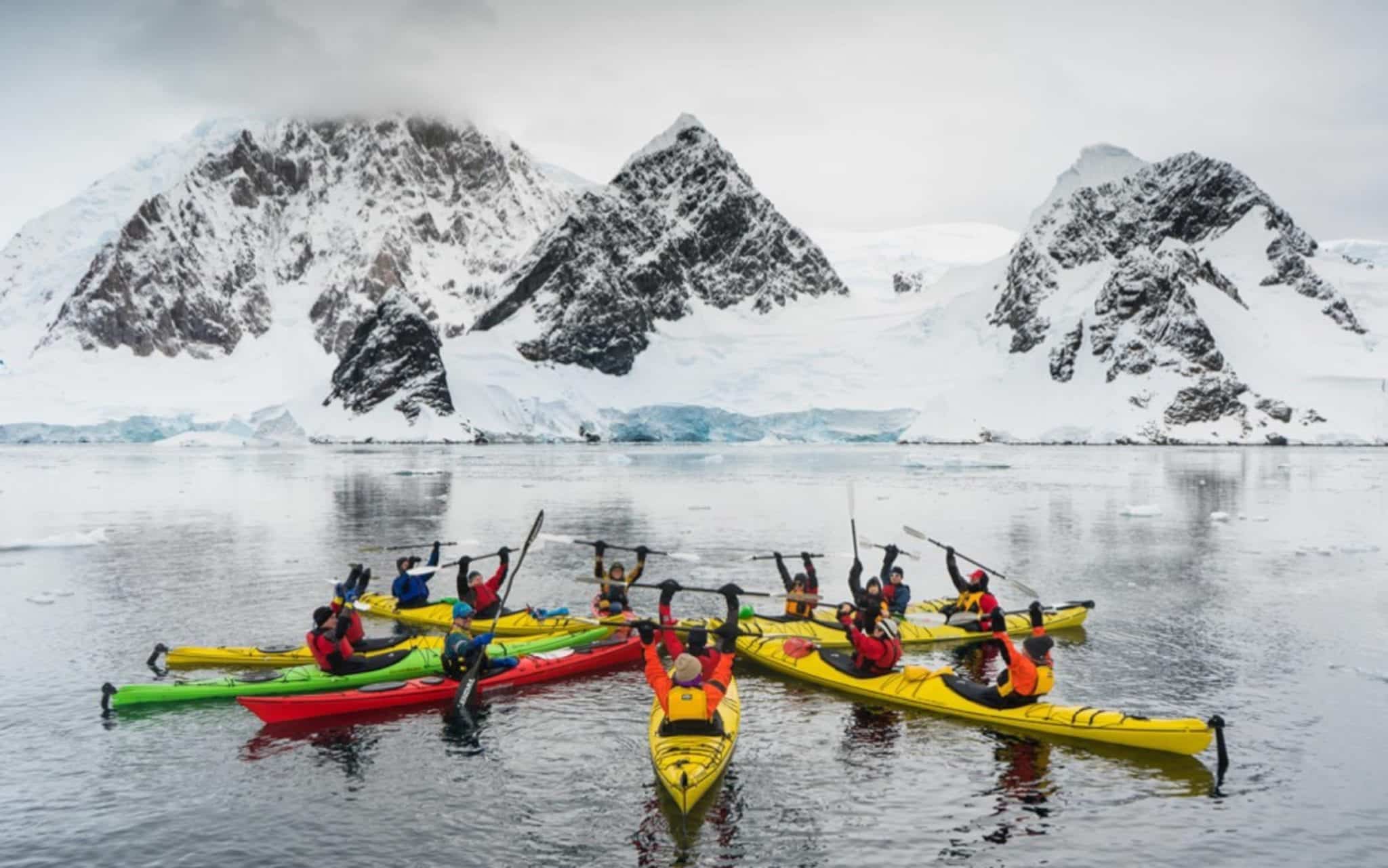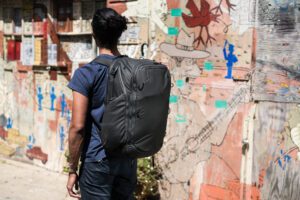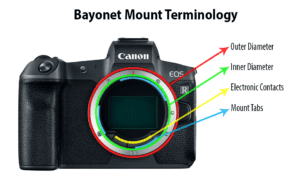
Kayaking in Antarctica is one of the most badass, unique, and special things I’ve ever done while traveling. Antarctica is wild, moving, and breathtaking, and there’s no better way to experience the continent than as close to the water as possible.
I traveled to Antarctica with Quark Expeditions, who sponsored my trip, in March 2018. Quark offers lots of excursions to fill out your expedition: camping, cross-country skiing, stand-up paddleboarding.
But kayaking? Kayaking is the big one, the special one, the one that people rave about.
It’s also very expensive.
How much does kayaking in Antarctica cost? Quark Expeditions charges $995 for the 2018-2019 season. Other companies charge fees in that neighborhood.
In other words, this isn’t an impulse purchase — you should only kayak if you really want to.
But is it worth it? I absolutely think that it is.

What’s it like to kayak in Antarctica? Myths vs. Reality.
When you choose to be part of the kayaking team in Antarctica, you’re going to be part of a small team that breaks off from the main group and paddles together as often as possible. You have a different experience from everyone else on the ship. Everyone else splits their excursions between zodiac cruises and landings on shore; as kayakers, you go out for a long paddle, then often a shorter landing on shore.
That’s both a good thing and a bad thing: you get to be close
Here are the myths and realities about the Antarctica kayak experience:
You don’t need to be a super athlete in order to kayak in Antarctica. I wouldn’t say that at all — but you definitely need to be somewhat in shape and have a basic level of fitness.
The waves aren’t high or scary at all. Most of our kayaking experiences were on smooth, nearly glassy waters. I’ve gone sea kayaking in many places rougher than Antarctica, and you don’t go out at all if the waves are too high or if the weather is rough.
You go kayaking whenever humanly possible. This isn’t a casual activity that you do once or twice — kayaking is the center of everything you do. Our group ended up going out kayaking eight times. Of course, how often you go out is entirely dependent on the conditions. If you don’t go out, you join the rest of the travelers on zodiacs and on shore.
The guides are there to help you. Our guides were Michael and Vickie, both French Canadians. You don’t be come an Antarctica kayaking guide if you’re not crazy about the polar regions! The guides let you do your own thing but they’re there for you if you need help.
It’s pretty rare for someone to fall in. It happened once on our trip. Steve was pretty good-natured about it. “Well, we did a polar plunge south of the Antarctic Circle, so I might as well do one north of the Antarctic Circle!”
And if it happens to you, you do your wet exit (more on that below), the guides will get you out, and you can either choose to stay out and kayak or have the driver take you back to the boat.

Reasons to Kayak in Antarctica
It’s a beautiful way to be close to nature. When you kayak, you can reach down and touch the water. You can grab a piece of ice from the water and suck on it, feeling the air bubbles pop in your mouth. You can watch penguins, seals, and whales glide through the water just inches from you.
It’s a great way to stay active. You’re going to be on an expedition for at least ten days — it’s easy to turn into a lazy slug. While there was a tiny fitness center on board the Ocean Diamond, it was extremely basic and I didn’t feel the urge to work out there. Also, the food on board is excellent and you’ll probably be eating a ton of it, and it’s good to have an option to work it off.
The camaraderie is amazing. The kayakers are a small group of 16 within the expedition of 200, and you really bond with each other. The other people on the ship don’t get that because different people end up in the zodiac each time.
Bragging rights. If you kayak in Antarctica, that’s a pretty badass thing to put on your travel resume.
You feel Antarctica more closely this way. Antarctica is such a moving destination. I threw my soul into writing about it but nothing will ever come close to describing the feeling accurately. When you’re in that environment, it’s so much nicer to be sitting quietly in the water, feeling the chilly droplets fly off the paddle and land on your face.

Reasons Not to Kayak in Antarctica
It really impedes your photography. I’m not going to lie — as a photographer, this is one of the worst things you can do for your work. It nearly killed me that I was missing out on so many photography opportunities.
Why is this? First off, stability. If you’re in a boat, you’re bobbing up and down and it’s hard to get a stable image, especially if you’re shooting from far away.
And secondly, kayaks aren’t designed to be used with fancy cameras. Every time I took my camera out of the dry bag, I felt like I was taking my life into my hands. I would barely shoot and then put it back in my bag, my heart thudding. And that’s when I had a few moments to put the paddle down in the first place.
See further below for tips on how to get the most out of your photography while kayaking.
You can’t kayak casually — you make a commitment for the whole trip. And that’s a big, long-term commitment. A lot of people aren’t up for that much physical activity each day; you may end up tired and regretting it.
You might not see as much quality wildlife. When you’re in the zodiac, your driver guns the motor whenever there’s an amazing wildlife sighting. Kayaking? That just doesn’t happen. You do see wildlife, but it’s more about being in the water and appreciating the nature around you.
You might feel isolated from the other guests. There really is a divide between the kayakers and everyone else. Everyone’s friendly and lovely, of course, but you may feel like you’re missing out.

Best of Both Worlds: Kayak for a Day
Starting in the 2018-2019 Antarctica season, Quark Expeditions will now offer a “paddling excursion,” a.k.a. “kayak for a day.” This is a perfect solution for someone who wants to try Antarctica kayaking but doesn’t want to commit to being a hardcore kayaker.
Michael told us that he was initially skeptical about the idea of inflatable kayaks, but once they tried them out, he was sold. They’re big, they’re extraordinarily difficult to tip over, and they’re made of the same durable rubber as the zodiacs. Perfect for beginners.
Best of all? It’s much cheaper. Currently a paddling excursion costs $225 rather than the $995 of kayaking on the whole Antarctica trip.
I’m really happy to hear of this new activity — it seems like it would be the perfect solution for lots of people.

Tips for Kayaking in Antarctica:
Protect your fingers and toes from the cold. This is perhaps my single most important tip: you will be ABSOLUTELY MISERABLE if you have cold fingers and toes.
For your hands, spend big money on the absolute best gloves or mittens you can find (these are good ones), and glove liners or running gloves underneath. Wear Hot Hands hand warmers in between your gloves or mittens and the liners. For your feet, wear sock liners, thick socks, and more Hot Hands hand warmers in between the liners and the socks.
Base layers are also extremely important. Many people swear by Icebreaker merino wool tops and leggings; I tried them but actually preferred the much cheaper Uniqlo base layer top and leggings.
Quark provides all the vital kayaking gear: the drysuit, booties, kayaking skirt, life vest, drybags, and of course the kayaks and paddles themselves. And if you need better gear, you can buy from the shop on board.
Get yourself in reasonably good shape before you go. You don’t have to be a marathoner, but at least go for long walks on a regular basis and be able to climb a few flights of stairs without having to stop.
Take your boots on the zodiac for landings. You wear booties that you zip over your drysuit while kayaking, but they’re not fun for landings — your feet can get very cold. On days when you’re kayaking and doing a landing afterward, I recommend bringing your boots, leaving them in the zodiac while you kayak, and changing into them before you land. So much more comfortable.
Hydrate. Antarctica can be very dry and you’re physically exerting yourself. Quark provides a bag-like water bottle, but I didn’t like how floppy it was — I recommend bringing a reusable aluminum bottle with a cantilever to connect it to the ropes on your kayak.
Learn how to do a wet exit. This is a requirement in advance. Look into classes around your neck of the woods. You don’t necessarily have to commit to a course, though of course it will be helpful — you can always ask the instructor if he or she would be willing to teach you to do a wet exit independently.
Consider a GoPro. If you don’t want to knock yourself out trying to get top-quality photos, just throw a GoPro on yourself with a head strap or chest strap and set it to shoot continuously. That way you can kayak to your heart’s content without stopping to take photos.

Should Photographers Kayak in Antarctica?
Honestly, if you’re a photographer and you want to kayak, you’re going to be making sacrifices on both ends. It’s nearly impossible to do both well. You’ll be impeding both your kayaking experience and your photography experience.
That said, it can be done. I have some tips.
Talk to your guides about your photography priorities and considering sitting out kayaking on the best photography day. While Antartica itineraries change on a whim, as soon as we learned we’d be visiting Cuverville Island, the guides told us that this would be the absolute best day for hanging out with penguins.
I chose not to kayak that day, as did a few other kayakers, and it was absolutely the right decision. I spent this day getting all the penguin photos and me-with-penguins photos in my yellow Quark jacket and blue pants.

Keep this in mind if you want to get good photos of yourself in Antarctica. The drysuits are functional but they look so goofy in photos!
Plan to pair up and be in a double kayak. First off, you could take your DSLR or big camera with you and put it in a dry bag, but the guides urged people with big cameras to only use the double kayaks, as the weight could make the single kayaks prone to capsizing.
Luckily I got paired up with my friend Brian on the first day and we became great kayaking partners. He didn’t mind my photo-taking at all — or if he did, he didn’t tell me! Even so, I tried not to take advantage and kept my photography to a minimum.
Best case scenario is if you’re traveling with your partner, you share a kayak with your partner, and your partner does the lion’s share of the kayaking while you do all of the photography. And it’s optimal if the photographer is the lighter person and sits in the front of the kayak.
Would I kayak again, knowing that I was screwing myself out of photography opportunities? Yes, I would. For me, the kayaking experience was so incredible it made up for me not getting the photos I wanted.

My Favorite Kayaking Spots in Antarctica
Every kayak spot in Antarctica has something special to offer. But for me, there were three that stood out:
Port Charcot. If you’re on a trip that crosses the Antarctic Circle, you may stop here. Jean-Baptiste Charcot, my favorite Antarctic explorer, landed here with his crew and their pet pig Toby. Port Charcot has lots of brash ice to paddle through. We even had a snowball fight, flinging them with our paddles! I quickly snapped a photo of the fight above.

Paradise Harbour. It lives up to its name — the bay is protected and thus you have the smoothest, most pristine waters, surrounded by mountains on all sides. It was the perfect environment in which to do a primal scream! Paradise Harbour is also home to a cool old Argentine station.

Image via Quark Expeditions
Wilhelmina Bay. More whales than you ever thought could exist in one place. At one point it seemed like every zodiac had their own pod to watch! That was where we had the craziest kayak moment of the trip — where a giant whale came up out of the water, nose first, right in front of us.
And my least favorite spot? Well, don’t expect to kayak on Deception Island. The conditions make it really tough to kayak there, and we had to sit it out. That said, it’s an interesting landing. I got charged by a sea lion.

I beg you: please don’t book kayaking in Antarctica unless you’re 100% committed to it.
Many of the passengers who book Antarctica kayaking don’t understand how much of a commitment they’re making. They don’t realize that they’ll be kayaking twice a day, physically exerting themselves, and missing out on landing time. (One Quark employee told me that this most often happens when people book through travel agents rather than directly with Quark.)
We had 200 passengers on our ship, the Ocean Diamond, and only 16 spots for kayakers. The kayaking spots went extremely quickly — they tend to sell out months in advance. And I can’t tell you how many people on board told me, “You’re kayaking? I’m jealous. I wanted to so badly but it was sold out.”
Another thing: if you’re traveling with your partner and one person really wants to kayak and the other doesn’t, you don’t both have to do it. You’ll make tons of friends and have plenty of time to spend with your partner when you’re on the ship. Let the limited kayaking spots go to people who really want them.
Kayaking in Antarctica isn’t for everyone. And that’s okay. No matter what you do in Antarctica, you’ll be experiencing one of the most remarkable destinations on the planet.

Essential Info: I traveled to Antarctica on Quark Expeditions‘ Crossing the Circle: Southern Expedition in March 2018. The 2019 voyage starts at $8,995. The kayaking supplement is $995, which includes kayaking throughout the voyage, but starting this summer in the Arctic Quark is offering one-day “paddling excursions” that are better suited for people with less experience who don’t want to kayak every day.
Quark often has sales — I recommend following them on Facebookand checking out their website. Additionally, some people can get deals by flying down to Ushuaia and jumping on a last-minute discounted trip — though this is risky! You never know what will be available. If you’re looking to kayak, book as early as possible, as kayaking slots are limited and sell out quickly.
See my Antarctica packing list for what to wear in Antarctica.
While Quark has Antarctica-specific evacuation coverage for emergencies, you need to have your own travel insurance as well. For my trip to Antarctica, I used World Nomads, which I highly recommend for both Antarctica and elsewhere.
This post is brought to you by Quark Expeditions, who hosted me in full on this trip and covered most of my expenses including the full cost of the expedition, kayaking supplement, two nights’ accommodation in Ushuaia, and round-trip airfare from New York. I paid for all incidentals, staff gratuities, gear excluding the Quark parka, and all expenses in Ushuaia excluding the hotel. All opinions, as always, are my own.
Would you kayak in Antarctica? Share away!
The post Kayaking in Antarctica: Everything You Need to Know appeared first on Adventurous Kate.

from Adventurous Kate https://www.adventurouskate.com/kayaking-antarctica/



































